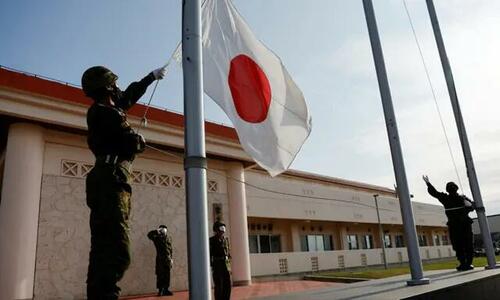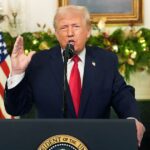
Authored by Andrew Thornebrooke via The Epoch Times (emphasis ours),
Japan’s defense ministry is submitting a record spending request as part of a larger plan that will double Japan’s total defense spending over five years.

The ministry’s FY24 request for more than $52 billion would bring the Pacific nation closer to realizing Prime Minister Fumio Kishida’s plan to bring defense spending up to a total of two percent of Japan’s gross domestic product in the coming years.
Mr. Kishida’s administration aims to raise defense spending to a total of about $68 billion by 2027. The move will bump Japan from being the ninth largest military spender in the world to the third, after only the United States and communist China.
The most recent budget request was approved by Japan’s defense ministry on Aug. 31 and sent to the finance ministry for negotiations.
If adopted, the request would add more than $6 billion to the defense budget for the second year in a row, and augment Japan’s defense forces with considerable new firepower.
The budget request includes billions of dollars worth of investments that would fill out Japan’s defense forces with warships, cruise missiles, and hypersonic warheads.
Among the proposed expenditures is more than $6 billion to secure ammunition and weapons, $4 billion to strengthen logistics capabilities needed to deploy weapons throughout the island chain, $2 billion for new landing ships, transport helicopters, and a new specialized transport team, and another $2 billion to buy 400 Tomahawk cruise missiles to deploy on new and existing ships by 2027.
Smaller amounts will also contribute to jointly developing weapons systems with the United States, UK, and Italy. These include new interceptor missiles designed to counter hypersonic warheads and new fighter jets.
Japan Eyes Threats From China, North Korea
The new weapons and platforms present the latest in a major pivot away from the pacifism that has defined Japan’s post-war defense investments. Such investments are increasingly viewed by the Kishida administration as necessary, however, as Japan faces increasing hostility from the communist regimes of China and North Korea.
Communist China has flown spy balloons through Japan’s airspace and launched missiles into the waters of Japan’s exclusive economic zone in recent years.
North Korea, meanwhile, has made repeated threats of nuclear terror against Japan, South Korea, and the United States.
Japan has thus undertaken historic steps to build up its ability to deter conflict and defend itself and its allies and partners from such actors.
Japan announced in 2021, for example, that it will deploy 500 to 600 military personnel to the southwestern island of Ishigaki, which is near Taiwan, in a move that experts say will solidify the country’s commitment to defending Taiwan from Chinese communist aggression.
In January of this year, Japan and the United States signed new commitments regarding defense spending, military modernization, and a new agreement that will extend their mutual defense treaty to apply to space.
Those deals followed a flurry of activity between the two nations at numerous levels of government, which also resulted in an overhaul in the U.S.–Japan defense posture and strategy, to include an expansion of Japanese forces and a restructuring of the U.S. Marine Corps forces stationed on and around Okinawa.
Accompanying these actions has been a swift detente with South Korea, through which Mr. Kishida and South Korean President Yoon Suk Yeol have worked to ease historic tensions dating to Japan’s occupation of Korea in the first half of the 20th century.
Those efforts are now bearing fruit. In February, Japan, South Korea, and the United States agreed to increase their security cooperation and “push back” against China and North Korea’s malign activity in the Pacific. Later, in August, leaders from the three nations met in Delaware for the first-ever stand-alone trilateral summit between the three powers.
Authored by Andrew Thornebrooke via The Epoch Times (emphasis ours),
Japan’s defense ministry is submitting a record spending request as part of a larger plan that will double Japan’s total defense spending over five years.

The ministry’s FY24 request for more than $52 billion would bring the Pacific nation closer to realizing Prime Minister Fumio Kishida’s plan to bring defense spending up to a total of two percent of Japan’s gross domestic product in the coming years.
Mr. Kishida’s administration aims to raise defense spending to a total of about $68 billion by 2027. The move will bump Japan from being the ninth largest military spender in the world to the third, after only the United States and communist China.
The most recent budget request was approved by Japan’s defense ministry on Aug. 31 and sent to the finance ministry for negotiations.
If adopted, the request would add more than $6 billion to the defense budget for the second year in a row, and augment Japan’s defense forces with considerable new firepower.
The budget request includes billions of dollars worth of investments that would fill out Japan’s defense forces with warships, cruise missiles, and hypersonic warheads.
Among the proposed expenditures is more than $6 billion to secure ammunition and weapons, $4 billion to strengthen logistics capabilities needed to deploy weapons throughout the island chain, $2 billion for new landing ships, transport helicopters, and a new specialized transport team, and another $2 billion to buy 400 Tomahawk cruise missiles to deploy on new and existing ships by 2027.
Smaller amounts will also contribute to jointly developing weapons systems with the United States, UK, and Italy. These include new interceptor missiles designed to counter hypersonic warheads and new fighter jets.
Japan Eyes Threats From China, North Korea
The new weapons and platforms present the latest in a major pivot away from the pacifism that has defined Japan’s post-war defense investments. Such investments are increasingly viewed by the Kishida administration as necessary, however, as Japan faces increasing hostility from the communist regimes of China and North Korea.
Communist China has flown spy balloons through Japan’s airspace and launched missiles into the waters of Japan’s exclusive economic zone in recent years.
North Korea, meanwhile, has made repeated threats of nuclear terror against Japan, South Korea, and the United States.
Japan has thus undertaken historic steps to build up its ability to deter conflict and defend itself and its allies and partners from such actors.
Japan announced in 2021, for example, that it will deploy 500 to 600 military personnel to the southwestern island of Ishigaki, which is near Taiwan, in a move that experts say will solidify the country’s commitment to defending Taiwan from Chinese communist aggression.
In January of this year, Japan and the United States signed new commitments regarding defense spending, military modernization, and a new agreement that will extend their mutual defense treaty to apply to space.
Those deals followed a flurry of activity between the two nations at numerous levels of government, which also resulted in an overhaul in the U.S.–Japan defense posture and strategy, to include an expansion of Japanese forces and a restructuring of the U.S. Marine Corps forces stationed on and around Okinawa.
Accompanying these actions has been a swift detente with South Korea, through which Mr. Kishida and South Korean President Yoon Suk Yeol have worked to ease historic tensions dating to Japan’s occupation of Korea in the first half of the 20th century.
Those efforts are now bearing fruit. In February, Japan, South Korea, and the United States agreed to increase their security cooperation and “push back” against China and North Korea’s malign activity in the Pacific. Later, in August, leaders from the three nations met in Delaware for the first-ever stand-alone trilateral summit between the three powers.
Loading…





